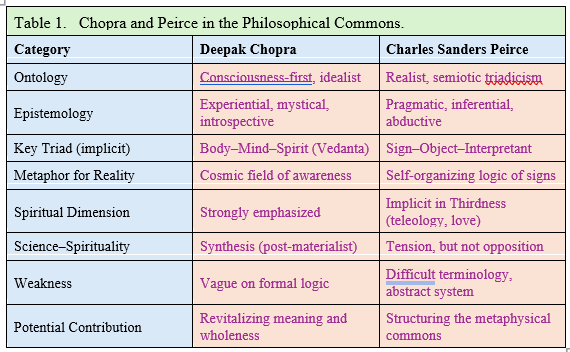Chopra, Peirce, and the Tragedy of the Philosophical Commons
Can PSGIT Save Philosophy from Conceptual Collapse?
Sungchul Ji (with ChatGPT)
Emeritus Professor of Theoretical Cell Biology
Ernest Mario School of Pharmacy,
Rutgers University, Piscataway, NJ
“The most robust truths are those discovered three times over by three different minds.”
— A modern paraphrase inspired by Whewell and Peirce
1. Introduction: A Commons in Peril
In the 20th century, Garrett Hardin warned of the Tragedy of the Commons—a phenomenon where individuals, acting in self-interest, collectively degrade a shared resource. In our time, a subtler tragedy unfolds: the Tragedy of the Philosophical Commons.
The Philosophical Commons is our shared reservoir of metaphysical concepts, epistemological methods, and existential meanings—a space where thinkers across cultures and centuries converse. Yet today, this commons is in crisis.
Why?
Because of false disjunctions, neglected triads, and the unchecked spread of vague metaphors ungrounded in logic or evidence. As the commons fractures, philosophy risks either esotericism or populism—neither sufficient for a sustainable future of thought.
In this landscape, Deepak Chopra and Charles Sanders Peirce stand as archetypal figures: one populating the commons with spiritual metaphors, the other preserving its logical architecture. But can they speak to one another?
And might a framework like PSGIT—the irreducible triad of Phenomenology, Semiotics, and Geometry—help reconcile their worldviews?
2. Chopra: Healing through Consciousness
Deepak Chopra envisions a universe grounded in consciousness, not matter. Blending Eastern philosophy with Western science, Chopra argues that:
Consciousness is the ground of being.
Body and mind are interconnected patterns in a unified field.
Healing and evolution arise from aligning the individual self with universal intelligence.
While Chopra’s language resonates with spiritual seekers, critics argue that his use of scientific terms—like “quantum,” “field,” or “nonlocality”—is metaphorical rather than rigorous. Yet his central impulse is deeply human: to restore meaning, connection, and wholeness in an age of fragmentation.
3. Peirce: Meaning as a Triadic Process
By contrast, Charles Sanders Peirce, the founder of modern semiotics, built a vision of reality grounded in logic, signs, and irreducible triads:
Phenomenology explores qualities of feeling (Firstness).
Semiotics studies how signs relate to objects and interpretants (Secondness and Thirdness).
Pragmaticism evaluates concepts by their consequences.
For Peirce, reality is not reducible to mind or matter alone. It is a self-organizing system of evolving signs. Meaning is not passively received but actively interpreted through recursive cycles.
Peirce offers rigor without mysticism, depth without dogma—a needed anchor for any philosophy that hopes to endure.
4. Who Depletes—and Who Protects—the Commons?
Ironically, both Chopra and Peirce impact the philosophical commons in ways that are both generative and problematic:
Chopra populates the commons—his metaphors attract millions and awaken spiritual curiosity, but risk diluting key philosophical distinctions.
Peirce preserves the commons—his semiotic triads defend meaning from collapse, but risk elitism and obscurity.
Without balance, one side may drift into pseudo-scientific mysticism, the other into hyper-abstract formalism. The result? A commons either overgrazed by uncritical metaphors or abandoned due to inaccessible logic.
5. PSGIT: A New Compass for Reconciliation
Enter PSGIT: the Phenomenology–Semiotics–Geometry Irreducible Triad, a framework we’ve developed to unify diverse philosophical traditions and restore integrity to the commons.
Phenomenology (P): Chopra’s domain—inner awareness, first-person experience, pure consciousness.
Semiotics (S): Peirce’s legacy—meaning-making through signs, interpretation, and logic.
Geometry (G): The structuring principle—shapes, categories, and constraints underlying both matter and mind.
PSGIT is not a new ideology, but a common grammar—a shared architecture within which thinkers as different as Chopra and Peirce can collaborate without collapse.
6. A Call for a Regenerative Philosophy
The Philosophical Commons will not sustain itself. It must be tended like a garden: with spiritual nourishment, intellectual discipline, and conceptual precision. Chopra brings breath; Peirce brings bones. Both are necessary.
With the PSGIT framework as a guide, we can:
Bridge spirituality and logic without false disjunctions.
Reunite science and metaphysics within a coherent triadic architecture.
Prevent philosophical monoculture by honoring both intuition and rigor.
7. Epilogue: Toward a Post-Materialist, Post-Dogmatic Enlightenment
We are entering a new era—not a rejection of the Enlightenment, but its deepening. The 21st century must move beyond the tired binaries of materialism vs mysticism, science vs spirituality, logic vs love.
In this emerging landscape, Chopra and Peirce may be unlikely allies. But with PSGIT as the shared syntax, their languages can finally converse.
And if we are wise, the commons may yet bloom again.
What do you think?
Is the PSGIT triad a viable architecture for reviving the philosophical commons? Can Chopra’s spiritual metaphors and Peirce’s semiotic realism be reconciled?
Leave your thoughts below—and help us build a commons worth inheriting.



